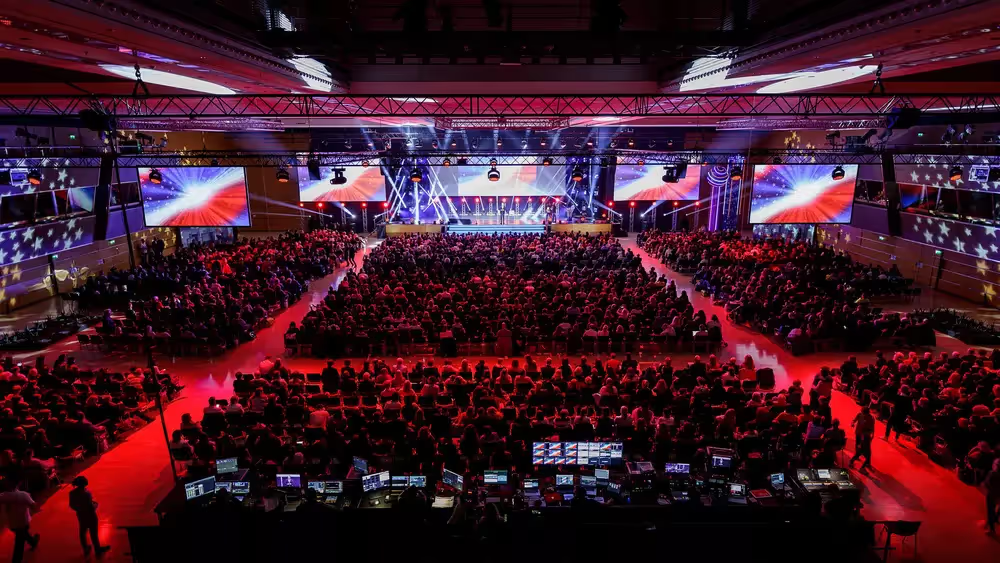What does event check-in mean?
Event check-in refers to the process of controlling entry at events. Guests are received to verify their access authorisation and record their attendance. There are basically two types of access control:
- Digital check-in solutions for automated guest registration.
- Manual check-in solutions in the form of printed Excel lists.
When is event check-in required?
Not every event requires access control. Events without registration options usually do not require access control. Access control is useful when:
- Tickets have been sold.
- There is high demand for a fully booked event.
- Attendance is mandatory (e.g., for employee events).
- The no-show rate needs to be determined.
- Different information needs to be communicated to participants and non-participants.
- Statistics for event marketing need to be collected.
- Fire safety regulations require occupancy limits.
Without access control, event planners lack important event data for organising and optimising event marketing.
Important considerations for event check-in
Before opening the doors, it is important for event organisers to consider possible scenarios and the process:
- How will guests arrive and what will be the flow of visitors?
- How long will the event check-in be operational?
- Where is the point of contact for issues like forgotten tickets?
- Who decides on access permissions in unforeseen circumstances?
- Are there special greetings for VIPs, speakers, or media?
- What are the responsibilities at the entrance?
- Is there an emergency plan and what are the evacuation routes?
Remember that there may be early birds as well as latecomers. Be prepared for both cases.
The support desk - essential for smooth entry!
For large events with over 200 participants, a support desk is essential to answer specific questions and handle special cases such as visitors without valid tickets. Ideally, the support desk should be placed separately from regular entry to avoid delays in visitor flow.
Optimising the visitor experience
Put yourself in your guests' shoes and optimise the event experience step by step:
- How is the arrival and parking situation?
- How do public transportation options arrive? Are there times when visitor congestion will be particularly high?
- What is the guest's first impression of the event?
- How should the guest be welcomed?
- How is coat check handled?
- When and where does the first programme item begin?
- Is there adequate signage?
Incorporate your insights into the staff briefing before opening the doors so that everyone is up to date.
Scheduling for check-in
To achieve entry to the event without significant wait times, the required entry time per guest must be calculated or estimated. This entry time depends heavily on how access control is conducted and what individual steps a guest must go through. If you have no experience, it's best to play out the process a few times and time how long it takes per guest. Then multiply the entry time per guest by the total number of participants to get the total check-in time required. With this value, you can estimate how many check-in stations are necessary. Generally, the event entry should not take more than an hour for 80% of your guests. Note that guests who arrive early may otherwise have too long of a wait until the event starts. Also, consider that a digital solution is faster than a manual one. Approximately 5 seconds can be assumed as a guideline per guest for stepping forward, showing a QR code or e-ticket, and scanning. However, if each guest needs to be asked for their name and there are misunderstandings, the entry of a single guest can quickly take several minutes.
Also note that a digital solution is faster than a manual one. Around 5 seconds per guest can be assumed as a guideline for entering, showing the QR code or e-ticket and scanning. If, on the other hand, every guest has to be asked for their name and there is some confusion, it can quickly take several minutes for a single guest to be admitted.
Integrated event check-in solution
The advantages are clear. By combining the registration and check-in solution, event data can be managed in one central location. This offers the following benefits:
- Easier evaluation options such as determining the no-show rate.
- Uncomplicated registration of late registrations.
- Better data quality.
- Real-time overview.
Offline availability of the event check-in solution
Most event locations have a powerful Wi-Fi infrastructure or very good mobile coverage. Nevertheless, the failure of an internet connection at the door opening is probably the worst-case scenario for any event organiser. Therefore, if your event check-in solution does not have an offline function, it is advisable to have a plan B for this worst-case scenario. A plan B could be, for example, to make a physical printout of the guest list and be prepared for this case.
Does your event require a check-out?
Check-out means that guests go through a check-out process when leaving the event, thus recording their departure from the event. For events with mandatory attendance, a check-out function may be justified. In practice, however, implementation is often not quite trivial, as, for example, even temporary exits from the event, for example for a phone call, must be recorded. This requirement can be solved somewhat more elegantly, for example, with a giveaway that is only distributed after a certain time of the event.




















.svg)















































































